

e-mail :  ( Please write in ' Subject ' entry : ' METAPHYSICS ', in order for me to be able to distinguish your mail from spam )
( Please write in ' Subject ' entry : ' METAPHYSICS ', in order for me to be able to distinguish your mail from spam )
Examples of the type :
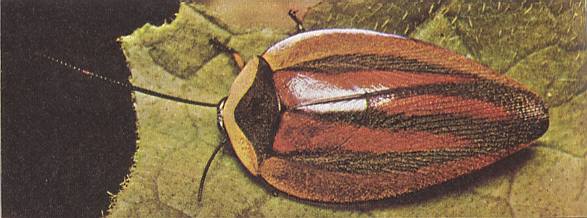
Cockroach from tropical South Amarica. Paratropes spec. Order Blattoidea [= Blattoptera = Blattaria] ).
(From Neue Grosse Tier-enzyklopädie, Band 4 Insekten, 1971)
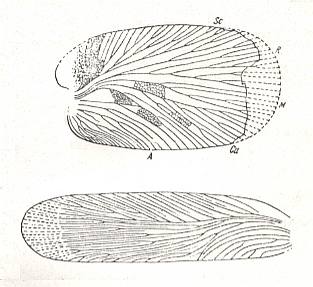
Figure 1 : Wings of fossil cockroaches ( Order Blattoidea [= Blattoptera = Blattaria] ).
Top image : Platyblatta steinbachensis Kl., Archimylacridae. Carboniferous of Western Europe. Forewing. The archedictyon (fine reticulation [meshwork] between the veins) not completely drawn. Length 37 mm. (After GUTHÖRL, in MARTYNOV).
Bottom image : Rhipidoblattina angustata Mart., Rhipidoblattinidae. Liassic [= lower Jurassic] of Fergana (Central Asia). Forewing. Length 12 mm. (After Martynov)
(From ROHDENDORF, 1949)
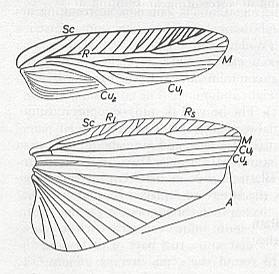
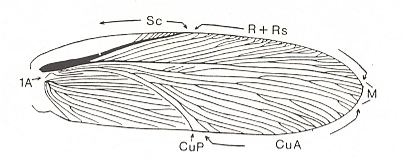
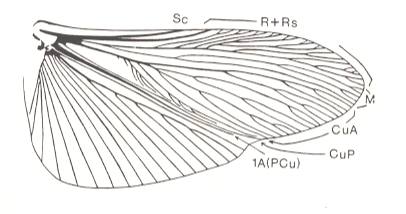
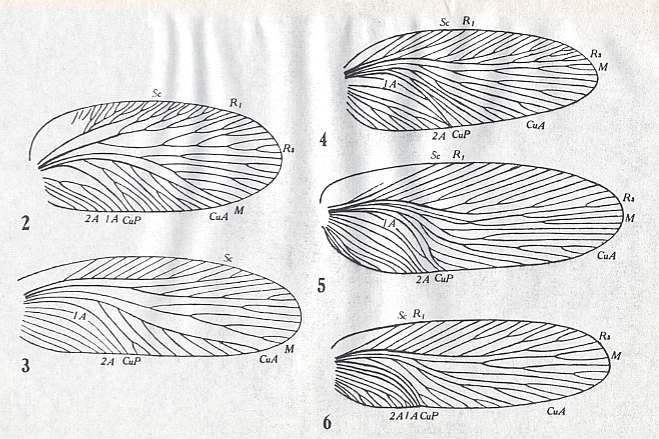
Figure 3 : Wings of Paleozoic and Mesozoic Cockroaches, Blattaria (= Blattoidea = Blattoptera).
2 : Forewing of Archimylacris lerichei Pruvost, Family Archimylacridae. Upper Carboniferous of France. Length 32.5 mm. (After PRUVOST).
1A - first Anal vein. 2A - second Anal vein. CuA - anterior Cubitus (convex). CuP - posterior Cubitus (concave), or vena dividens. M - Media. R1 - main stem of Radius. Rs - Radial Sector. Sc - Subcosta.
3 : Forewing of Sysciophlebia euglypticha Germar. Family Spiloblattinidae. Upper Carboniferous of Germany. Length 27 mm. (After HANDLIRSCH). Lettering as in 2.
4 : Forewing of Triassoblatta typica Till. Family Mesoblattinidae. Upper Triassic of Ipswich, Queensland, Australia. Length 12 mm. (After TILLIARD). Lettering as in 2.
5 : Forewing of Samaroblatta reticulata Till. Family Mesoblattinidae. Upper Triassic of Ipswich, Queensland, Australia. Length 10.5 mm. (After TILLYARD). Lettering as in 2.
6 : Forewing of Rhipidoblattina geikiei Scudder. Family Mesoblattinidae. Lias [= lower Jurassic] of England. Length 13 mm. (After HANDLIRSCH). Lettering as in 2.
(In TILLYARD, 1937)
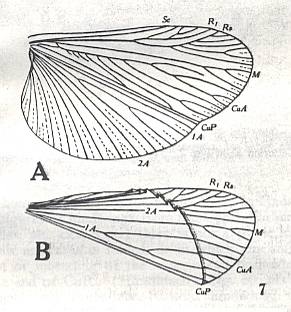
Figure 4 : Hindwing of Oniscosoma granicollis Sauss., male. Family Panchloridae (Blattaria). Recent, Australia. Length 23 mm. A - The expanded hindwing. B - The folded hindwing, ventral view. (After TILLYARD, 1937)

Figure 5 : Forewing (tegmen) of Permoblattina curta Sellards. Family Spiloblattinidae. Lower Permian of Kansas, USA. Length 15 mm. (After TILLYARD, 1937)
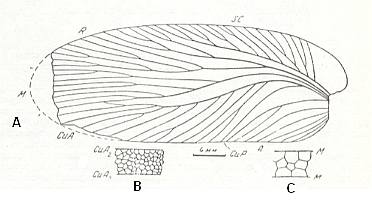
Figure 6 : Phyloblatta carbonica B.-M. A - tegmen [forewing]. B, C -- archedictyon. Family Archimylacridae. Carboniferous of basin of Kuznets, Siberia. (After ROHDENDORF et al., 1961)
Description of the type.
Differentiations and connections of the type.
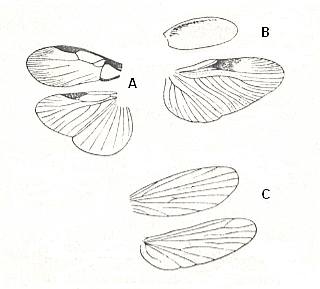
Figure 7 : Wings of [some very specialized] recent cockroaches.
A - Hypercompsa fieberi Brun., Euthyrrhaphidae, South America. Length 6-7 mm. (After HANDLIRSCH).
B - Euthyrrhapha pacifica Coq., Euthyrrhaphidae, South America. Tegmen 5 mm. (After BRUNNER, in HANDLIRSCH).
C - Cardax willeyi Shelf., Cardacidae, India. Length 6 mm. (After KARNY in HANDLIRSCH).
(In ROHDENDORF, 1949)
Representatives of the type
Persistence of the basic venational scheme in tegmina. Its theoretical significance.
In many insects the forewings have been transformed into more or less tough stiffened shields, elytra. Most of all, this phenomenon is expressed in the Order Coleoptera (beetles) where the forewings together form a tough box protecting most of the body. Because the original venation has no function anymore it has as such disappeared in most beetles. In many other insects, on the other hand, the forewings are stiffened in a lesser degree, and have become hemelytra or tegmina, as we see them in many Homoptera such as in Cercopidae (Cercopoidea, frog-hoppers, cuckoo-spit insects) and their permian-triassic relatives the Scytinopteridae, while in Heteroptera (bugs) the forewings are hardened only in their basal half (foreshadowed by the permian Prosbolidae). In cockroaches the forewings, tegmina, are in a fairly strong degree stiffened all over, but the original venation is still clearly preserved. And that venation has turned out very persistent indeed. We find it in all carboniferous, permian, triassic, jurassic, and cenozoic cockroaches including most recent ones. Of course one may expect great individual variability in the details of this venation in many species of them because of the high degree of non-functionality of the venation of tegmina preventing to stabilize it. So when apparently a great many 'species' of cockroach are being described from some particular paleozoic or mesozoic fauna, many of them may well be mere individual variations of a same species. So we cannot maintain that the original venation of the tegmen "has persisted in so many species". But if we consider fossil cockroach faunae of widely separated localities, or of different geological periods, then we can be sure that we are speaking of truly different species of cockroach. Let us then select a number of these fossil tegmina found in different localities and also those that belong to different geological periods :
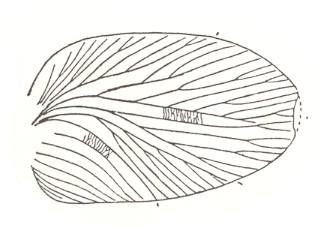
|
Cardioblatta Fritschi Schlechtendal. Family Mylacridae. Order Blattaria. Tegmen. Length 16.5 mm. Upper Upper-Carboniferous of Wettin in Sachsen, Germany. (After HANDLIRSCH, 1906). |
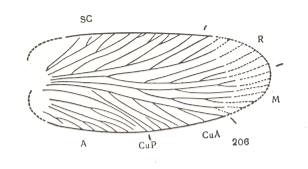
|
Hemimylacris clintoniana Scudder. Family Mylacridae. Order Blattaria. Tegmen. Length 19 mm. Middle Carboniferous of North America. (After SCUDDER, 1895). |
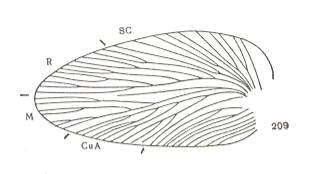
|
Mylacris anthracophila Scudder. Family Mylacridae. Order Blattaria. Tegmen. Length 33 mm. Middle Carboniferous of North America. (After SCUDDER, 1895). |
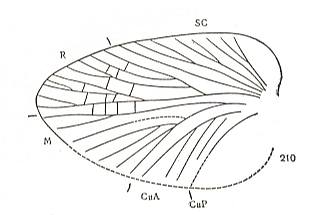
|
Pseudomylacris wettinensis Schlechtendal. Family Mylacridae. Order Blattaria. Tegmen. Length 7.3 mm. Upper Carboniferous of Germany. (After HANDLIRSCH, 1906). |
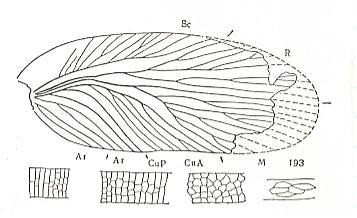
|
Grypoblattites flabellatus Becker-Migdisova. Family Archimylacridae. Order Blattaria. Tegmen. Length 22 mm. Middle Carboniferous of Kuznets Basin, Siberia, Russia. (After BECKER-MIGDISOVA, 1961). |
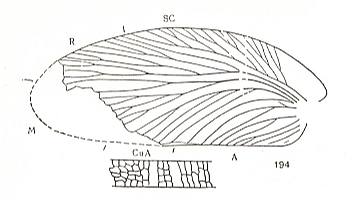
|
Archaeotiphites petroblattinoides Becker-Migdisova. Family Archimylacridae. Order Blattaria. Tegmen. Length 38 mm. Middle Carboniferous of Kuznets Basin, Siberia, Russia. (After BECKER-MIGDISOVA, 1961). |
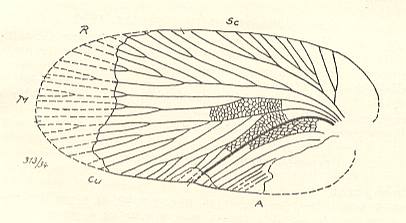
|
Etoblattina primaeva Goldenberg. Family Archimylacridae. Order Blattaria. Tegmen. Length of preserved part 27.0 mm. Total length about 33.0 mm. Middle Upper-Carboniferous of Saar Region, Germany. (After GUTHÖRL, 1934). |
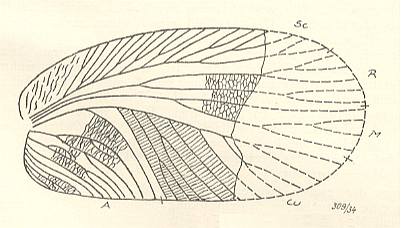
|
Archimylacris diensti Guthörl. Family Archimylacridae. Order Blattaria. Tegmen. Length of preserved part 15.0 mm. Total length about 22.0 mm. Middle Upper-Carboniferous of Saar Region, Germany. (After GUTHÖRL, 1934). |
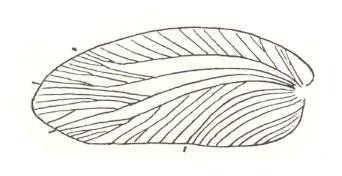
|
Sysciophlebia arcuata Sellards. Family Spiloblattinidae. Order Blattaria. Tegmen. Length 24 mm. Upper Upper-Carboniferous of Kansas, USA. (After SELLARDS, in HANDLIRSCH, 1906). |
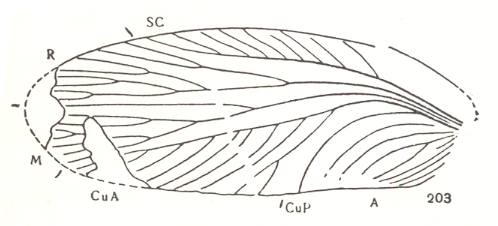
|
Sysciophlebia zavjalovensis Becker-Migdisova. Family Spiloblattinidae (or Archimylacridae, subfamily Spiloblattininae). Order Blattaria. Tegmen. Length 25.8 mm. Middle Carboniferous of Kuznets Basin, Siberia, Russia. (After BECKER-MIGDISOVA, 1961). |
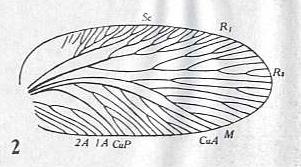
|
Forewing of Archimylacris lerichei Pruvost, Family Archimylacridae. Order Blattaria. Upper Carboniferous of France. Length 32.5 mm. (After PRUVOST, in TILLYARD, 1937). (Figure 3, above) |

|
Phyloblatta carbonica B.-M. A - tegmen [forewing]. B, C -- archedictyon. Family Archimylacridae. Carboniferous of Basin of Kuznets, Siberia. (After ROHDENDORF et al., 1961) (Figure 6, above) |

|
Forewing (tegmen) of Permoblattina curta Sellards. Family Spiloblattinidae. Lower Permian of Kansas, USA. Length 15 mm. Specimen No 15663 (After TILLYARD, 1937) (Figure 5, above) |
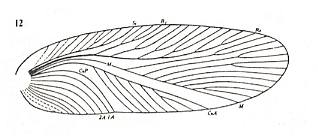
|
Forewing (tegmen) of Permoblattina curta Sellards. Family Spiloblattinidae. Lower Permian of Kansas, USA. Length 13.6 mm. Specimen No 15669. (After TILLYARD, 1937) |
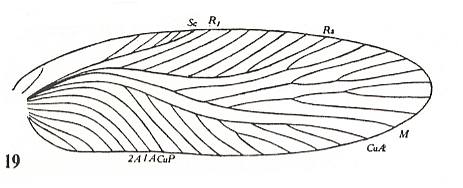
|
Forewing (tegmen) of Pycnoblattina compacta Sellards. Family Spiloblattinidae. Lower Permian of Kansas, USA. Length 10.8 mm. (After TILLYARD, 1937) |
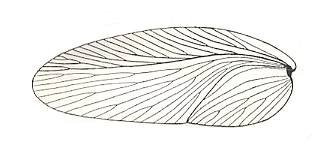
|
Restoration of the tegmen of Triassoblatta typica Tillyard. Family Mesoblattinidae. Upper Triassic of Ipswich, Queensland, Australia. Length 11.7 mm. (After TILLYARD, 1919) (Figure 3). |
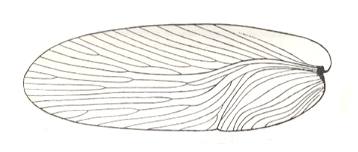
|
Restoration of the tegmen of Samaroblatta reticulata Tillyard. Family Mesoblattinidae. Upper Triassic of Ipswich, Queensland, Australia. Length 13.7 mm. The intercalated ridges and cross-venation are omitted (see next Figure). (After TILLYARD, 1919) (Figure 3). |
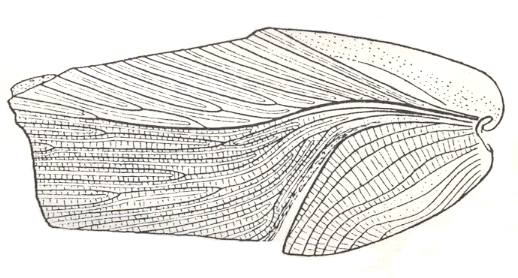
|
Left tegmen of Samaroblatta reticulata Tillyard. Family Mesoblattinidae. Upper Triassic of Ipswich, Queensland, Australia. Greatest length of preserved portion of tegmen nearly 10.5 mm. Probable total length of tegmen nearly 14 mm. (After TILLYARD, 1919) |
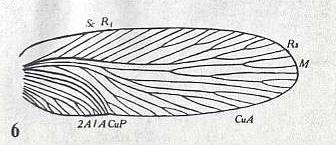
|
Forewing (tegmen) of Rhipidoblattina geikiei Scudder. Family Mesoblattinidae. Order Blattaria. Lias [= lower Jurassic ] of England. Length 13 mm. (After HANDLIRSCH, in TILLYARD, 1937) (Figure 3) |
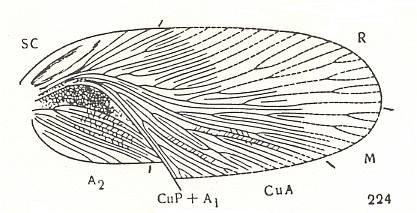
|
Forewing (tegmen) of Taublatta kisylkiensis Martynov. Family Mesoblattinidae. Order Blattaria. Lower Jurassic of Central Asia. Length 15.8 mm. (From MARTYNOV, 1937, in ROHDENDORF et al., 1962) |
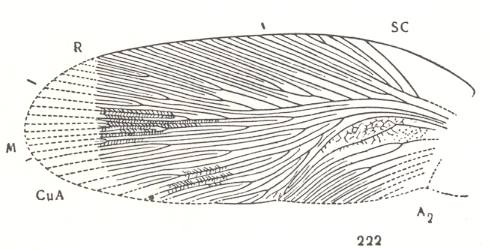
|
Forewing (tegmen) of Sogdoblatta robusta Martynov. Family Mesoblattinidae. Order Blattaria. Lower Jurassic of Central Asia. Length 21.8 mm. (From MARTYNOV, 1937, in ROHDENDORF et al., 1962) |
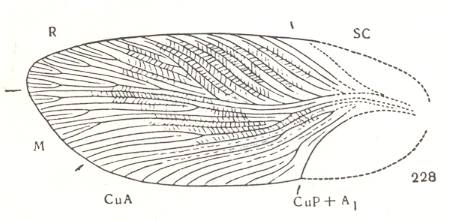
|
Forewing (tegmen) of Samaroblattula subacuta Martynov. Family Mesoblattinidae. Order Blattaria. Lower Jurassic of Central Asia. Length 13.3 mm. (From MARTYNOV, 1937, in ROHDENDORF et al., 1962) |
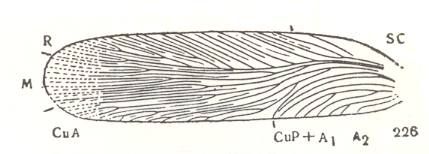
|
Forewing (tegmen) of Rhipidoblattina angustata Martynov. Family Mesoblattinidae. Order Blattaria. Lower Jurassic of Central Asia. Length 12 mm. (From MARTYNOV, 1937, in ROHDENDORF et al., 1962) |
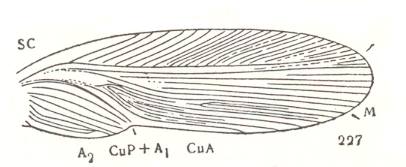
|
Forewing (tegmen) of Mesoblattina multivenosa Martynov. Family Mesoblattinidae. Order Blattaria. Lower Jurassic of Central Asia. Length 11.7 mm. (From MARTYNOV, 1937, in ROHDENDORF et al., 1962) |
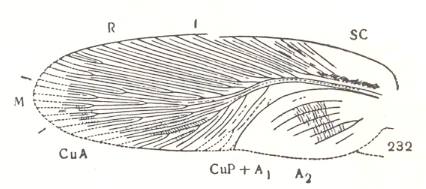
|
Forewing (tegmen) of Samaroblatta tillyardi Martynov. Family Mesoblattinidae. Order Blattaria. Lower Jurassic of Central Asia. Length 18 mm. (From MARTYNOV, 1937, in ROHDENDORF et al., 1962) |
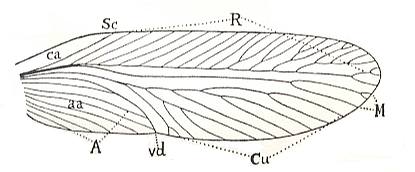
|
Tegmen of Escala circumducta Walker. Family Blattidae. Recent, Australia. Length 12.3 mm. ca - costal area. aa - anal area. vd - vena dividens. (After TILLYARD, 1919) |
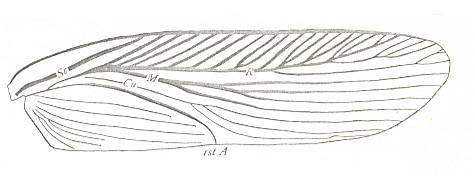
|
Right tegmen of Phyllodroma germanica. Family Blattidae. Recent. (After COMSTOCK, 1918) According to more recent interpretation "1st An" = CuP. Later this form was taken to be : Blattella germanica, family Epilampridae. |
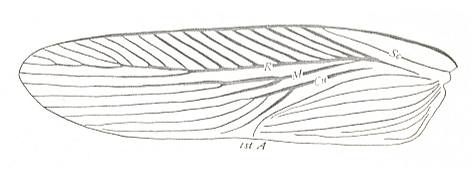
|
Left tegmen of same individual of Phyllodroma germanica. Family Blattidae. Recent. (After COMSTOCK, 1918) According to more recent interpretation "1st An" = CuP. Later this form was taken to be : Blattella germanica, family Epilampridae. |

|
Venation of tegmen of Periplaneta americana. Family Blattidae. Recent. (After SMART, 1951, in HENNIG, 1981) |
In the context of our latest version of noëtic theory of evolution, -- in which it is taken that not only all organismic species (as they are visible in the Explicate Order) but also all corresponding strategies (as immaterial forms -- descriptions -- developed and present in the Implicate Order) have developed independently of one another (i.e. polyphyletically) [see our theoretical discussions in Part II and Part IV ], -- we cannot, concerning the above figured (and many others) Blattaria, say that the structure of the general venational scheme in the forewings (tegmina) has "persisted" in so many (i.e. almost all) blattarian forms in all geological epochs in which insects were present at all. Rather we should say that the original immaterial forms, that have, in the Implicate Order, developed into true strategies, and which, upon projection, have given the corresponding blattarian species from the Carboniferous up to the present time, were quite similar to each other. They were variations of one and the same original immaterial form. And the strategies, having noëtically developed from these forms, have, when materialized, turned out to be very successful indeed in the Explicate Order : The way of life is quite similar in most recent Blattaria, and is assumed to be not much different in all their precursors. It is a very generalized, i.e. unspecialized way of life, mainly so determined by saprophagy and polyphagy. And so, with the one restriction of them being mainly lovers of warm and moist environments, they could (and did) appear almost anywhere in all geologic periods. During the day they remain hidden among vegetable debris, but at night they go out in search of food, being skilled runners. And connected with this way of life is their flight apparatus (belonging to the present type blattopterygia). Although the Blattida generally possess well developed wings, they do not exploit their, albeit limited, flying-ability fully. As a rule they use their wings only to lengthen a down-jump. In this the tegmina are moved independently of the fluttering hindwings. Often they use the wings only to soften and accurately direct the jump, using them just before landing in a gliding fashion.
Note on classification.
According to ROHDENDORF and RASNITSYN, 1980, the Order Blattaria (Blattida) -- the majority of which representing the present wing-type blattopterygia -- consists of two Suborders, viz., the Mylacridina (middle Carboniferous - upper Cretaceous), and the Blattina (lower Cretaceous - Recent).
To the suborder Mylacridina do belong four superfamilies, viz., Archimylacridoidea, Mylacridoidea, Mesoblattinoidea, and the Raphidiomimoidea).
The superfamily Archimylacridoidea is, in addition to features other than the wings, characterized by a rich venation of the semi-leathery or leathery tegmina (forewings), the place of attachment of which to the thorax being shifted towards the anterior margin, and by the relatively small ano-jugal region of the hindwing folded under its anterior part not in a fan-like fashion. Such a wing-apparatus clearly belongs to the present wing-type, blattopterygia. The oldest findings of representatives of this superfamily are from the middle Carboniferous of North America and Western Europe, the latest from the upper Cretaceous of Siberia and Kazachstan. Of the main family Archimylacridae we know more than 100 genera and 500 species. (ROHDENDORF and RASNITSYN, 1980).
The superfamily Mylacridoidea is (in addition to features other than the wings) characterized by broadened compact tegmina, the place of attachment of them to the thorax being at the middle of their base, by the costal field being triangular, SC with branches radially given off from the base, and the ano-jugal region of the hindwings being not large, apparently not being folded fan-like. The chief family, Mylacrididae, is known by 20 genera and 70 species. The most ancient mylacridoids are found in the middle Carboniferous of western Europe and North America, the youngest in the upper Permian of Africa.
The superfamily Mesoblattinoidea is (again in addition to features other than the wings) characterized by elongate tegmina with sigmoidal R, M, and CuA, by a reduced costal field, a distally little-branched or simple SC, the Radial system supporting the anterior margin up to the apex, M and CuA being developed in different degree, and the anal region being elongate, its veins falling upon the posterior margin of the tegmen. Further, the ano-jugal region of the hindwings is enlarged, it folds fan-like. The oldest remains of representatives of this superfamily have been found in the upper Carboniferous of western Europe and North America, the youngest in the lower Cretaceous of Transbaikal and Mongolia. The chief family, Mesoblattinidae, is known from 50 genera and 120 species. [At least the latter family is, according to MÜLLER, A. H., 1978, not found in the Paleozoic. Its geochronological range is said to be Triasssic-Upper Cretaceous.]
The elongated tegmina and the fan-like ano-jugal area of the hindwings of the representatives of this superfamily (Mesoblattinoidea) foreshadow (or maybe already represent) the wing-type orthopterygia (straight-wingedness) (Part V ), meaning that the Blattaria do represent not only one, but two different chief wing-types (blattopterygia and orthopterygia).
The superfamily Raphidiomimoidea is (among other features) characterized by a prognathous head, an elongate pronotum [= dorsal shield of prothorax], and semi-leathery tegmina. To this superfamily belongs the only family Raphidiomimidae with two genera and three species from the upper Jurassic of Kazachstan. (ROHDENDORF and RASNITSYN, 1980)
In the suborder Blattina the wings have been developed in various degrees, sometimes they are atrophied. It contains three superfamilies, viz., Corydioidea, Blattoidea, and Blaberoidea. The most ancient Blattina are known from the early Cretaceous. (ROHDENDORF and RASNITSYN, 1980)
The superfamily Corydioidea (= Polyphagoidea) is (in addition to features other than the wings) characterized by the ano-jugal region of the hindwings not being folded fan-like. There is one family : Corydiidae (= Polyphagidae), including more than 40 genera and existing from upper Cretaceous times up to the present.
The superfamily Blattoidea is characterized (among other characters) by the wing-organs being developed in different degrees or atrophied. The ano-jugal region of the hindwing folds fan-like. Chief family : Blattidae with about 40 genera. The oldest Blattoidea are found in the lower Cretaceous of Siberia. (ROHDENDORF and RASNITSYN, 1980)
The superfamily Blaberoidea is (among other features) also characterized by the development of the wing-organs in different degrees or by their atrophy. The ano-jugal region of the hindwing folds fan-like. Two families, viz., Blattellidae (about 140 genera) and Blaberidae (about 70 genera). The oldest remains of the Blaberoidea are known from the Paleogene [lower Tertiary] of western Europe. (ROHDENDORF and RASNITSYN, 1980).
Polyphyletic versus monophyletic descent
We might ask the following question :
Are the morphological relations -- similarities and differences of venational patterns or details of them -- as they exist in the complete collection of tegmina (known and unknown) of fossil and recent cockroaches, of such a nature that these tegmina and their bearers do belong to definite lines of actual descent from one another, that is, does each tegmen-differing-in-a-fixed-way-from-any-other, has its determined place somewhere in the genealogic tree of the Blattaria, or do they not?
In answering this question, we consider some venational differences that can be detected in these tegmina.
Let us inspect the structure and extent of the subcostal and radial systems of veins in a number of blattarian tegmina (chosen from the above set of figured tegmina [or, if necessary, from elsewhere] ). In the tegmen of Acrimylacris diensti from the middle upper-Carboniferous of Germany, we see a long Subcosta with many more or less parallel veinlets branching off from it and connecting it with the costal border (i.e. the anterior wing-margin). Coming after this structure we see the Radial vein, apparently branching in a dichotomic fashion (absence of a clear distinction between R1 and RS). Going, in that tegmen, further down posterior to R, we meet M, CuA, the simple CuP, and the anal veins. So we are sure about our having recognized the true Subcosta and the true Radius.
In Sysciophlebia arcuata from the upper Carboniferous of Kansas, USA, we see this same configuration of SC and R even more clearly, and the Radius tends to be pectinately branched toward the apical anterior wing-margin next to the branches of the Subcosta.
The same configuration we see in Sysciophlebia zavjalovensis from the middle (or upper?) Carboniferous of Siberia (kuznets basin).
When, on the other hand, we inspect the tegmen of Pycnoblattina compacta from the lower Permian of Kansas, USA, we see that Subcosta is somewhat reduced, not reaching mid-point of anterior wing-margin, while the Radius has increased the number of its anterior veinlets, forming a long pectinate series of veins, a series next to that of the Subcosta, connecting the Radius with the anterior wing-margin.
This process is carried still further in Rhipidoblattina geikiei from the lower Jurassic of England, and also already in Samaroblatta reticulata from the upper Triassic of Queensland, Australia. And it is carried to an end in, for instance, the recent Escala circumducta from Australia and the recent Phyllodroma germanica from the USA (and, undoubtedly, in many other recent cockroaches). Subcosta has become a single vein without veinlets branching off from it, while the Radius has increased the number of veinlets connecting it with the anterior wing-margin.
In all this we have to do with the supplanting of the subcostal system by the radial system, i.e. R takes the place of SC. We would be tempted to say that "the Radius has functionally become the Subcosta". Whatever it is, it is not a mere addition of one or two branches or veinlets to a given existing vein, i.e. it is not some more or less random variation. It is a true re-construction or transformation of the anterior part of the tegmen. But because, as we may assume, the venational configuration in the tegmina of most cockroaches is functionless (being merely an expression of the deeper qualitative and commonly possessed core of the qualitative content of the species) the Radius having supplanted the Subcosta cannot be the result of a change of function of this part of the tegmen, i.e. it has no reason or cause at all to be formed from the original configuration (SC well developed with many veinlets). And this further implies that it has not formed from some other configuration, but is simply different from it. The so-called "derived" configuration (SC strongly reduced, R having extended its series of subparallel veinlets toward the anterior wing-margin) has appeared completely independently from the so-called "original" configuration (SC well developed, long, with many subparallel veinlets toward the anterior wing-margin).
As to the family Spiloblattinidae (middle Carboniferous - early Jurassic) figuring in the above morphogenetic sequence (Sysciophlebia) we may add, following ROHDENDORF and RASNITSYN, 1980, p. 143, that they developed from Archimylacidae by development of improvement of flight, being well-flying diurnal cockroaches with elongate membranous wings, having lived on plants and laying their eggs into the tissues with the help of a saw-like ovipositor. But because such Spiloblattinidae were already represented by cockroaches still having an extensive subcostal system of veins, the subsequent reduction of that system and the replacement of it by the radial system (see Pycnoblattina) has nothing to do with the mentioned improvement of flight.
A case like this adds up to the number of strong arguments in favor of polyphyletic instead of monophyletic development in organisms.
And yet another such argument.
In the great majority of Carboniferous fossil tegmina of Blattaria there is a delicate close network of cross-veins all over the tegmen. This is apparently a specialization from the older and more irregular palaeodictyopterous meshwork, or archedictyon. Intercalated veins are very rarely developed. In the mesozoic fossils, on the other hand, intercalated veins are often well developed (see for instance Taublatta, Sogdoblatta, and many others.) from the lower Jurassic of Central Asia), while the close network of cross-veins is more rarely found. Most recent forms have the intercalated veins well developed. And there still exist a number with the cross-venation persisting, though it is seldom of so close a type as in the Carboniferous forms.
And also here, because the venational pattern in blattarian tegmina apparently has no function, we cannot say that the configuration characterized by the presence of a great many intercalated veins has actually been formed from a configuration without them. The two configurations are simply different from each other. They have appeared in the Explicate Order independently from each other. And although the recent cockroaches are relatively uniform as to their way of life, we do not know anything more precise of the way of life of the fossil forms. Although we may reasonably assume that it was like that in recent forms, we have to suppose the existence of subtle ecological differences, i.e. we must assume the appearance in geologic history of slightly different ecological types of cockroaches, and it might well be that the presence of intercalated veins is morphologically, but not functionally, determined by a certain ecological type represented by many cockroaches in the Mesozoic and later periods.
As to the Mesoblattinidae figuring in the just given discussion about intercalary veins we may add, following ROHDENDORF and RASNITSYN, 1980, p, 144, that this family is characterized by a further strengthening of flight capabilities of the wings and a fan-like folding (when at rest) of the ano-jugal region of the hindwings. The mesoblattinids, apparently, lived on the vegetation and layed their eggs in cracks of bark and similar cracks in the substrate. And, although we do not know of earlier cockroach wings, not belonging to the Mesoblatinidae, but also having forewings provided with intercalary veins, it is unlikely that the appearance of such veins has something to do with improving the flight-qualities of the wings.
As to the question of actual transformation or independent appearance, the same can be said of the configuration of the anal veins in the clavus of blattarian tegmina. To begin with, we have a configuration in which all anal veins end up at the posterior margin of the clavus (see for instance Pycnoblattina compacta ), and then, after having found intermediate configurations (see Escala circumducta ), there is a configuration in which all anal veins end up in the vena dividens (CuP) (see Phyllodroma ). Also this is not a mere random variation, but a true re-construction or transformation of a given region in the wing. But also here we must use the terms "re-construction" and "transformation" purely morphologically, i.e. statically. They should not indicate certain processes that have actually taken place in the history of blattarian tegmina. The two claval configurations are simply different, and have appeared in the Explicate Order independently of one another.
If the venation of a tegmen or wing should be responsible for evenly stiffening it only, we, of course may expect the veins to be evenly distributed over the tegmen's surface. And indeed we see this in the tegmina of a number of carboniferous cockroaches such as Cardioblatta, Hemimylacris, Mylacris, and Pseudomylacris. And, apparently, 'after' these forms a specialization of the tegmen sets in, such as in Grypoblattites, Archaeotiphites, and many others. But this trend [as we may so express ourselves when following the successive appearance of forms in geologic time] wasn't pressed on very much, so that the tegmina of even most of the recent forms (see for instance in Escala and Phyllodroma ) have their veins more or less evenly distributed. Also the tegmen's clavus (its shape and venation) was not much further developed beyond the venational configuration already mentioned. So we may wonder why even the first specialization (to be seen when we go from, say, Hemimylacris (or Cardioblatta ) to, say Archaeotiphites ) took place at all. Surely, in all Mylacridae and Archimylacridae the forewings were true tegmina, i.e. organs shielding hindwings and body. Therefore, apart from very modest transformations, special flight-functional or other adaptations cannot be expected in these insects. All this may mean that the observed changes in the shape and venation of the tegmina of Blattaria in the course of geologic time are not functionally 'motivated'. And this implies that they should not have taken place at all, at least not in the fixed ways as they apparently did. ( This is especially true in the context of current evolutionary theory in which only profitable genetic mutations are consolidated by natural selection). So again, our conclusion is that all these forms have appeared independently of one another, not the one type having evolved from another. And indeed, the families Mylacridae, Archimylacridae, Spiloblattinidae, and Mesoblattinidae, respectively representing the main types of blattarian tegmina, all [except the latter] were already present in the Carboniferous.
Paleozoic blattarian faunae in Europe, America, and Asia.
Tegmina of cockroaches of paleozoic age are found in great numbers in certain, often coal-bearing, strata at some points in Europe, America, and Asia (Siberia). A literature study of three of these faunae, viz., the Saar-basin (Germany), the Coal-measures near Wettin (Germany), and the Dunkard Basin (USA), was done by me in 1988 when writing a co-called "non-philosophical paper" required for concluding my academic study of philosophy at the Municipal University of Amsterdam. The study of these three blattarian faunae was appended to a larger whole, the mentioned non-philosophical paper, dealing with the evolution of the Class of [all] Insects.
For the things dealt with in the present website (Part V and VI of Website) the study of the three mentioned blattarian faunae (and now added to them that of the Kuznetz Basin, Siberia) has the following points of interest :
In the next six documents ( together forming some sort of appendix of the present document, i.e. the present part III ) we will successively deal with these four paleozoic blattarian faunistic complexes, viz., that of the Saar Basin (part IIIaa ), that of the Wettiner Basin (part IIIb ), that of the Dunkard Basin (part IIIc ), and that of the Kuznets Basin (part IIId ), and after that we will continue our study of wing-types in insects, that is, we will describe the next wing-type, elytropterygia (shield-wingedness, part IV ). But before doing so we will, in the next document, extensively describe the geological and ecological context of these basins as they are situated on the northern half of the Pangea Supercontinent.
So with the present document we conclude the description of blattopterygia. In the next document we will describe the surface of Pangea in carboniferous and permian times.
e-mail :
 ( Please write in ' Subject ' entry : ' METAPHYSICS ', in order for me to be able to distinguish your mail from spam )
( Please write in ' Subject ' entry : ' METAPHYSICS ', in order for me to be able to distinguish your mail from spam )
To continue click HERE for the geology and ecology of the Pangea Supercontinent. Part IIIa.